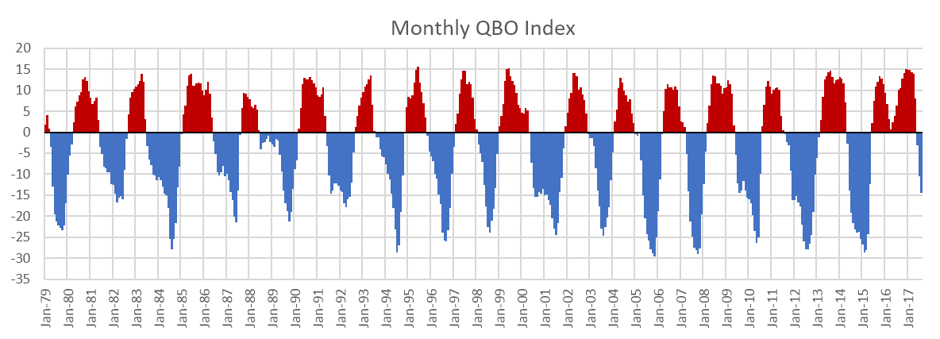Will the Negative QBO Increase the Odds for a Colder Winter this Year?
by Stephen Strum, on Nov 2, 2017 2:48:30 PM
The QBO, or Quasi-Biennial Oscillation, is an oscillation in the wind direction in the stratosphere within about 15 degrees of the equator. Over a roughly two-year period, winds tend to oscillate between westward and eastward, with the switch between west and east winds starting high in the stratosphere and then shifting lower in altitude with time. The QBO is the result of waves propagating vertically in the atmosphere that then interact with the mean flow to slowly change wind speeds and direction. These changes influence the overall global circulation patterns, which in turn influence winter weather patterns across North America. The following plot shows the regular cycle in the QBO. Interestingly, the QBO has been positive for the last two winters, a highly unusual event. Since last winter, the QBO has turned sharply negative though, and that negative trend should continue into the upcoming winter.

So, how does the QBO tend to modulate winter temperatures across the US? The following plot shows four QBO regimes and the resulting winter temperatures across the US. The QBO index is a function of the speed and direction of the winds in the stratosphere over the equator, and so it is crucial how the QBO is trending in addition to the actual value of the index. The following plot shows four different QBO regimes. “A” denotes winter seasons when the QBO is both negative and trending more negative. “B” denotes winter seasons when the QBO is negative but trending in a positive direction. “C” denotes winter seasons when the QBO is positive, but trending negative. “D” denotes winters when the QBO is positive and trending more strongly positive. Winter seasons tend to be coldest when the QBO is in regime “A” and warmest when in regime “D”. Also, when the QBO is trending in a negative direction the western US tends to be warmer than the eastern US, and when the QBO is trending in a positive direction, the eastern US tends to be warmer than the western US. Last winter was a regime “D” scenario where the QBO was positive and trending more strongly positive heading into the winter season. This year, the QBO is negative and trending more negative with time, or regime “A”. 
So, the QBO trends would seem to favor a much colder winter than last year, and a potentially colder than normal winter in general. While it is likely that the QBO (along with some other factors) will help to keep this winter colder than the last two winters, it is not at all sure that this winter will average below normal. The QBO is just one of many factors that influence winter temperatures, the combination of which is more important than any individual factor. But, by itself, the QBO trends do suggest that at the very least this winter should be colder than last winter. We will be looking at more potential drivers of the winter temperature pattern in the coming weeks, so stay tuned!
To learn more about what to expect this winter, sign up for my FREE Winter Weather Outlook now.








